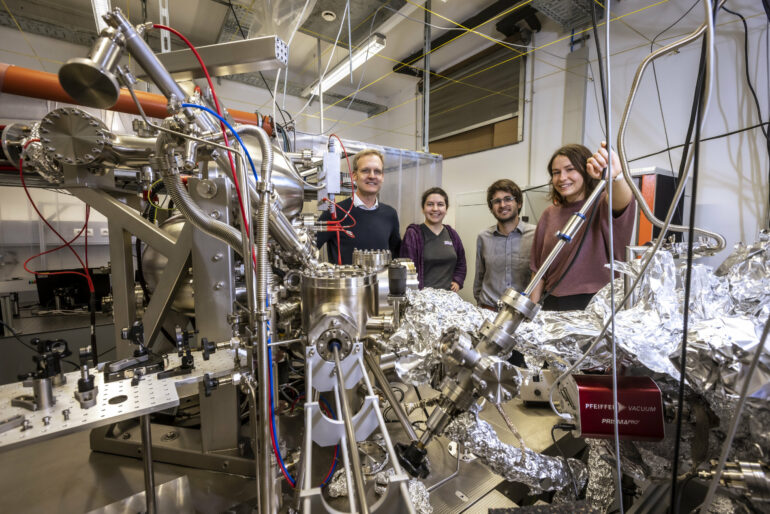Developed at Harvard, and successfully tested at Graz University of Technology (TU Graz), a revolutionary new meta-optics for microscopes with extremely high spatial and temporal resolution has proven its functional ability in laboratory tests at the Institute of Experimental Physics at TU Graz.
Microscopes using this kind of lens promise completely new research and development approaches, especially in semiconductor and solar cell technology. The research team from Graz and Boston currently reports on the construction and the successful laboratory experiment with this new meta-optics in the journal Science.
The lens of the microscope has made it possible to use extreme ultraviolet radiation for the first time. Its extremely short wavelength enables it to follow ultra-fast physical processes in the attosecond range. For example, real-time images from the inside of modern transistors or the interaction of molecules and atoms with light. Marcus Ossiander came up with the idea for the novel lens during his research work in Federico Capasso’s group at Harvard University, and since January 2023, the ERC Starting Grant and FWF START Award winner has been conducting research at the Institute of Experimental Physics at TU Graz.
Joint success for Boston and Graz
Attosecond physics uses extreme ultraviolet light. Because this light oscillates quickly and all the materials in the construction kit of optics development are opaque to this light, there have been no usable imaging systems for it until now. Marcus Ossiander remarks, “I asked myself whether the classical principle of optics could not be reversed. Can you use the absence of material in small areas as the basis of an optical element?”
The lens developed at Harvard on the basis of this idea and successfully tested at TU Graz implements this design principle. A precisely calculated arrangement of tiny holes in an extremely thin silicon foil conducts and focuses the incident attosecond light. A remarkable observation of the research team is that these vacuum tunnels transmit more light energy than should be possible due to the hole-covered surface. This means that the innovative meta-optics literally sucks the ultraviolet light into the focal point.
Holes of a few nanometers in diameter
Extremely small and precisely controlled structures are required for this breakthrough. Their production is close to the limits of what is technically feasible today. The technical implementation was achieved by Federico Capasso’s team at Harvard, which is the world leader in this field, after an experimental phase of around two years.
Proof of functionality was achieved in collaboration with TU Graz, where Martin Schultze’s group at the Institute of Experimental Physics is dedicated to the generation and application of ultra-short ultraviolet light flashes. “This is a great success for the cooperation between Boston and Graz. Now we want to use it to study microelectronics, nanoparticles and similar things soon,” explains Marcus Ossiander.
The meta-optics consists of an approximately 200-nanometer-thin film into which tiny hole structures have been etched. The entire lens consists of many hundreds of millions of holes; there are about ten of these structures per micrometer on the membrane. A single hole measures between 20 and 80 nanometers in diameter. For comparison: a human hair is about 60 to 100 micrometers thick, a small virus has a diameter of 15 nanometers. The diameters of the holes vary and decrease from the center of the membrane outwards. Depending on the size of the hole, the incident light radiation there is delayed and thus collapses into a tiny focal point.
Laser meets gas cloud
To measure the new type of lens, Martin Schultze and Hana Hampel from the Institute of Experimental Physics at TU Graz have unique expertise in generating the necessary extreme ultraviolet radiation. “Reliably generating short light pulses with high energy requires precise control of light-controlled atomic processes and very precise optical set-ups. For this project, we have developed a light source that is particularly efficient in generating radiation of the wavelength for which these meta-optics were designed,” says Martin Schultze.
In the experimental set-up in Graz, where a laser was focused into an inert gas jet, the extreme ultraviolet radiation could be generated and concentrated in very short pulses. The effectiveness of the meta-optics was proved by means of this light source which was optimized for attosecond physics.
Next step: A microscope with meta-optics
The development of a microscope that works with this lens is now the next step. The possible applications for the new research field of attosecond microscopy are manifold. Semiconductor and solar cell technology in particular will benefit from the possibility of being able to track the ultrafast movement of charge carriers in space and time for the first time.
In modern transistors and optoelectronic circuits, the relevant processes take place within a few nanometers of spatial expansion and in a time frame of a few attoseconds. The new meta-optics will make it possible to watch these central components of information technology at work and optimize them even further.
More information:
Marcus Ossiander et al, Extreme ultraviolet metalens by vacuum guiding, Science (2023). DOI: 10.1126/science.adg6881. www.science.org/doi/10.1126/science.adg6881
Provided by
Graz University of Technology
Citation:
Ultra-fast light at the end of the vacuum tunnel: Meta-optics shows physical processes in the attosecond range (2023, April 6)



